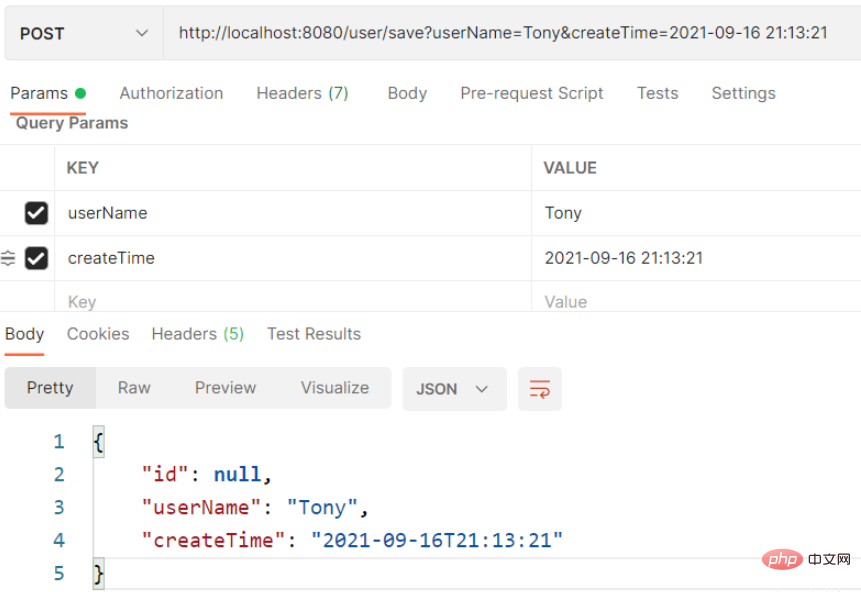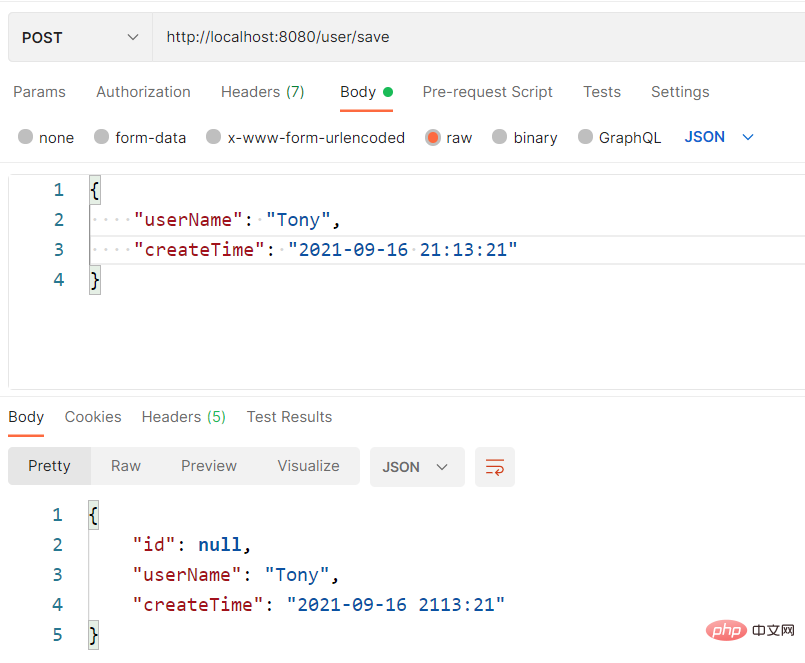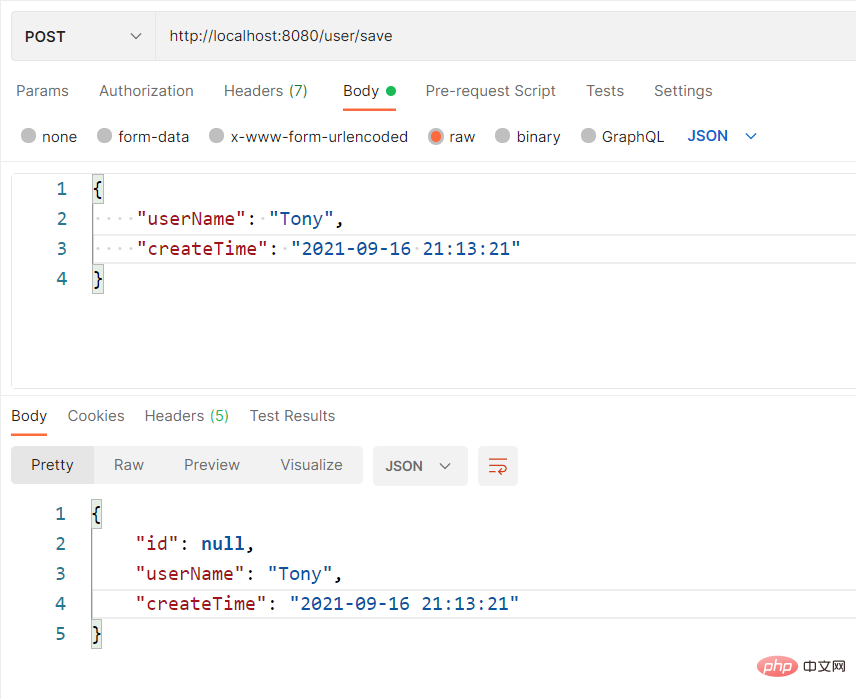What is the method for SpringBoot LocalDateTime format conversion?
Introduction
Description
We often have scenes of front-end and back-end time conversion in projects, such as: creating time, update time, etc. Generally, the front and back ends use the timestamp or year, month and day format for transmission.
If the backend receives the front-end parameters and manually converts them into the desired format every time, it would be too troublesome for the backend to manually process the data into the desired format every time it passes the data to the front-end.
Introduction to the solution
It needs to be configured in two scenarios (according to different Content-Type):
1.application/x-www-form-urlencoded and multipart/ form-data
This situation is recorded here as: not using @RequestBody
2.application/json
That is: using the interface of @RequestBody
This situation is recorded as: using @RequestBody
Remarks
Some people say that it can be configured like this:
spring:
jackson:
date-format: yyyy-MM-dd HH:mm:ss
time-zone: GMT 8
serialization:
write-dates-as-timestamps: false
This configuration is only applicable to Date, not LocalDateTime, etc.
Date serialization/deserialization uses this format: "2020-08-19T16:30:18.823 00:00".
Do not use @RequestBody
Option 1: @ControllerAdvice @InitBinder
Configuration class
package com.example.config;
import org.springframework.web.bind.WebDataBinder;
import org.springframework.web.bind.annotation.ControllerAdvice;
import org.springframework.web.bind.annotation.InitBinder;
import java.beans.PropertyEditorSupport;
import java.time.LocalDate;
import java.time.LocalDateTime;
import java.time.LocalTime;
import java.time.format.DateTimeFormatter;
@ControllerAdvice
public class LocalDateTimeAdvice {
@InitBinder
protected void initBinder(WebDataBinder binder) {
binder.registerCustomEditor(LocalDateTime.class, new PropertyEditorSupport() {
@Override
public void setAsText(String text) throws IllegalArgumentException {
setValue(LocalDateTime.parse(text, DateTimeFormatter.ofPattern("yyyy-MM-dd HH:mm:ss")));
}
});
binder.registerCustomEditor(LocalDate.class, new PropertyEditorSupport() {
@Override
public void setAsText(String text) throws IllegalArgumentException {
setValue(LocalDate.parse(text, DateTimeFormatter.ofPattern("yyyy-MM-dd")));
}
});
binder.registerCustomEditor(LocalTime.class, new PropertyEditorSupport() {
@Override
public void setAsText(String text) throws IllegalArgumentException {
setValue(LocalTime.parse(text, DateTimeFormatter.ofPattern("HH:mm:ss")));
}
});
}
}Entity
package com.example.business.entity;
import lombok.AllArgsConstructor;
import lombok.Data;
import java.time.LocalDateTime;
@Data
@AllArgsConstructor
public class User {
private Long id;
private String userName;
private LocalDateTime createTime;
}Controller
package com.example.business.controller;
import com.example.business.entity.User;
import org.springframework.web.bind.annotation.PostMapping;
import org.springframework.web.bind.annotation.RequestMapping;
import org.springframework.web.bind.annotation.RestController;
@RestController
@RequestMapping("user")
public class UserController {
@PostMapping("save")
public User save(User user) {
System.out.println("保存用户:" + user);
return user;
}
}Test
postman visit: http://localhost:8080/user/save? userName=Tony&createTime=2021-09-16 21:13:21
postman result:


Configuration Class
package com.example.config;
import org.springframework.context.annotation.Bean;
import org.springframework.context.annotation.Configuration;
import org.springframework.core.convert.converter.Converter;
import java.time.LocalDateTime;
import java.time.format.DateTimeFormatter;
@Configuration
public class LocalDateTimeConfig {
@Bean
public Converter<String, LocalDateTime> localDateTimeConverter() {
return new LocalDateTimeConverter();
}
public static class LocalDateTimeConverter implements Converter<String, LocalDateTime> {
@Override
public LocalDateTime convert(String s) {
return LocalDateTime.parse(s, DateTimeFormatter.ofPattern("yyyy-MM-dd HH:mm:ss"));
}
}
}Entity
package com.example.business.entity;
import lombok.AllArgsConstructor;
import lombok.Data;
import java.time.LocalDateTime;
@Data
@AllArgsConstructor
public class User {
private Long id;
private String userName;
private LocalDateTime createTime;
}Controller
package com.example.business.controller;
import com.example.business.entity.User;
import org.springframework.web.bind.annotation.PostMapping;
import org.springframework.web.bind.annotation.RequestMapping;
import org.springframework.web.bind.annotation.RestController;
@RestController
@RequestMapping("user")
public class UserController {
@PostMapping("save")
public User save(User user) {
System.out.println("保存用户:" + user);
return user;
}
}Test
postman access: http://localhost:8080/user/save?userName=Tony&createTime=2021-09-16 21:13:21postman results:

Method 1: Only use the configuration classThis method only configures the ObjectMapper. Entity does not need to add @JsonFormat.
Configuration Class
package com.knife.example.config;
import com.fasterxml.jackson.core.JsonParser;
import com.fasterxml.jackson.databind.DeserializationContext;
import com.fasterxml.jackson.databind.MapperFeature;
import com.fasterxml.jackson.databind.ObjectMapper;
import com.fasterxml.jackson.databind.deser.std.DateDeserializers;
import com.fasterxml.jackson.databind.ser.std.DateSerializer;
import com.fasterxml.jackson.datatype.jsr310.JavaTimeModule;
import com.fasterxml.jackson.datatype.jsr310.deser.LocalDateDeserializer;
import com.fasterxml.jackson.datatype.jsr310.deser.LocalDateTimeDeserializer;
import com.fasterxml.jackson.datatype.jsr310.deser.LocalTimeDeserializer;
import com.fasterxml.jackson.datatype.jsr310.ser.LocalDateSerializer;
import com.fasterxml.jackson.datatype.jsr310.ser.LocalDateTimeSerializer;
import com.fasterxml.jackson.datatype.jsr310.ser.LocalTimeSerializer;
import lombok.SneakyThrows;
import org.springframework.boot.autoconfigure.jackson.JacksonProperties;
import org.springframework.context.annotation.Bean;
import org.springframework.context.annotation.Configuration;
import org.springframework.http.converter.json.Jackson2ObjectMapperBuilder;
import java.text.SimpleDateFormat;
import java.time.LocalDate;
import java.time.LocalDateTime;
import java.time.LocalTime;
import java.time.format.DateTimeFormatter;
import java.util.Date;
@Configuration
public class JacksonConfig {
@Bean
public ObjectMapper objectMapper(Jackson2ObjectMapperBuilder builder,
JacksonProperties jacksonProperties) {
ObjectMapper objectMapper = builder.build();
// 把“忽略重复的模块注册”禁用,否则下面的注册不生效
objectMapper.disable(MapperFeature.IGNORE_DUPLICATE_MODULE_REGISTRATIONS);
objectMapper.registerModule(configTimeModule());
// 重新设置为生效,避免被其他地方覆盖
objectMapper.enable(MapperFeature.IGNORE_DUPLICATE_MODULE_REGISTRATIONS);
return objectMapper;
}
private JavaTimeModule configTimeModule() {
JavaTimeModule javaTimeModule = new JavaTimeModule();
String localDateTimeFormat = "yyyy-MM-dd HH:mm:ss";
String localDateFormat = "yyyy-MM-dd";
String localTimeFormat = "HH:mm:ss";
String dateFormat = "yyyy-MM-dd HH:mm:ss";
// 序列化
javaTimeModule.addSerializer(
LocalDateTime.class,
new LocalDateTimeSerializer(DateTimeFormatter.ofPattern(localDateTimeFormat)));
javaTimeModule.addSerializer(
LocalDate.class,
new LocalDateSerializer(DateTimeFormatter.ofPattern(localDateFormat)));
javaTimeModule.addSerializer(
LocalTime.class,
new LocalTimeSerializer(DateTimeFormatter.ofPattern(localTimeFormat)));
javaTimeModule.addSerializer(
Date.class,
new DateSerializer(false, new SimpleDateFormat(dateFormat)));
// 反序列化
javaTimeModule.addDeserializer(
LocalDateTime.class,
new LocalDateTimeDeserializer(DateTimeFormatter.ofPattern(localDateTimeFormat)));
javaTimeModule.addDeserializer(
LocalDate.class,
new LocalDateDeserializer(DateTimeFormatter.ofPattern(localDateFormat)));
javaTimeModule.addDeserializer(
LocalTime.class,
new LocalTimeDeserializer(DateTimeFormatter.ofPattern(localTimeFormat)));
javaTimeModule.addDeserializer(Date.class, new DateDeserializers.DateDeserializer(){
@SneakyThrows
@Override
public Date deserialize(JsonParser jsonParser, DeserializationContext dc){
String text = jsonParser.getText().trim();
SimpleDateFormat sdf = new SimpleDateFormat(dateFormat);
return sdf.parse(text);
}
});
return javaTimeModule;
}
}Entity
package com.example.business.entity;
import lombok.Data;
import java.time.LocalDateTime;
@Data
public class User {
private Long id;
private String userName;
private LocalDateTime createTime;
}Controller
package com.example.business.controller;
import com.example.business.entity.User;
import org.springframework.web.bind.annotation.PostMapping;
import org.springframework.web.bind.annotation.RequestBody;
import org.springframework.web.bind.annotation.RequestMapping;
import org.springframework.web.bind.annotation.RestController;
@RestController
@RequestMapping("user")
public class UserController {
@PostMapping("save")
public User save(@RequestBody User user) {
System.out.println("保存用户:" + user);
return user;
}
}Test

Save user: User(id=null, userName=Tony, createTime=2021- 09-16T21:13:21)Method 2: Configure class @JsonFormatThis method needs to configure ObjectMapper, and Entity also needs to add @JsonFormat.
Configuration Class
import com.fasterxml.jackson.databind.ObjectMapper;
import com.fasterxml.jackson.datatype.jdk8.Jdk8Module;
import com.fasterxml.jackson.datatype.jsr310.JavaTimeModule;
import com.fasterxml.jackson.module.paramnames.ParameterNamesModule;
import org.springframework.boot.autoconfigure.jackson.JacksonProperties;
import org.springframework.boot.jackson.JsonComponent;
import org.springframework.context.annotation.Bean;
import org.springframework.context.annotation.Configuration;
import org.springframework.http.converter.json.Jackson2ObjectMapperBuilder;
@Configuration
public class JacksonConfig {
@Bean
public ObjectMapper serializingObjectMapper(Jackson2ObjectMapperBuilder builder,
JacksonProperties jacksonProperties) {
ObjectMapper objectMapper = builder.build();
// 把“忽略重复的模块注册”禁用,否则下面的注册不生效
objectMapper.disable(MapperFeature.IGNORE_DUPLICATE_MODULE_REGISTRATIONS);
// 自动扫描并注册相关模块
objectMapper.findAndRegisterModules();
// 手动注册相关模块
// objectMapper.registerModule(new ParameterNamesModule());
// objectMapper.registerModule(new Jdk8Module());
// objectMapper.registerModule(new JavaTimeModule());
// 重新设置为生效,避免被其他地方覆盖
objectMapper.enable(MapperFeature.IGNORE_DUPLICATE_MODULE_REGISTRATIONS);
return objectMapper;
}
}Entity
package com.example.business.entity;
import com.fasterxml.jackson.annotation.JsonFormat;
import lombok.Data;
import java.time.LocalDateTime;
@Data
public class User {
private Long id;
private String userName;
@JsonFormat(pattern = "yyyy-MM-dd HH:mm:ss", timezone = "GMT+8")
private LocalDateTime createTime;
}Controller
package com.example.business.controller;
import com.example.business.entity.User;
import org.springframework.web.bind.annotation.PostMapping;
import org.springframework.web.bind.annotation.RequestBody;
import org.springframework.web.bind.annotation.RequestMapping;
import org.springframework.web.bind.annotation.RestController;
@RestController
@RequestMapping("user")
public class UserController {
@PostMapping("save")
public User save(@RequestBody User user) {
System.out.println("保存用户:" + user);
return user;
}
}Test

Save user: User(id=null, userName=Tony, createTime=2021- 09-16T21:13:21)Option 2: Jackson2ObjectMapperBuilderCustomizer
import com.fasterxml.jackson.datatype.jsr310.deser.LocalDateDeserializer;
import com.fasterxml.jackson.datatype.jsr310.deser.LocalDateTimeDeserializer;
import com.fasterxml.jackson.datatype.jsr310.deser.LocalTimeDeserializer;
import com.fasterxml.jackson.datatype.jsr310.ser.LocalDateSerializer;
import com.fasterxml.jackson.datatype.jsr310.ser.LocalDateTimeSerializer;
import com.fasterxml.jackson.datatype.jsr310.ser.LocalTimeSerializer;
import org.springframework.boot.autoconfigure.jackson.Jackson2ObjectMapperBuilderCustomizer;
import org.springframework.context.annotation.Bean;
import org.springframework.context.annotation.Configuration;
import java.time.LocalDate;
import java.time.LocalDateTime;
import java.time.LocalTime;
import java.time.format.DateTimeFormatter;
@Configuration
public class LocalDateTimeConfig {
private final String localDateTimeFormat = "yyyy-MM-dd HH:mm:ss";
private final String localDateFormat = "yyyy-MM-dd";
private final String localTimeFormat = "HH:mm:ss";
@Bean
public Jackson2ObjectMapperBuilderCustomizer jackson2ObjectMapperBuilderCustomizer() {
return builder -> {
// 反序列化(接收数据)
builder.deserializerByType(LocalDateTime.class,
new LocalDateTimeDeserializer(DateTimeFormatter.ofPattern(localDateTimeFormat)));
builder.deserializerByType(LocalDate.class,
new LocalDateDeserializer(DateTimeFormatter.ofPattern(localDateFormat)));
builder.deserializerByType(LocalTime.class,
new LocalTimeDeserializer(DateTimeFormatter.ofPattern(localTimeFormat)));
// 序列化(返回数据)
builder.serializerByType(LocalDateTime.class,
new LocalDateTimeSerializer(DateTimeFormatter.ofPattern(localDateTimeFormat)));
builder.serializerByType(LocalDate.class,
new LocalDateSerializer(DateTimeFormatter.ofPattern(localDateFormat)));
builder.serializerByType(LocalTime.class,
new LocalTimeSerializer(DateTimeFormatter.ofPattern(localTimeFormat)));
};
}
}Copy after login
import com.fasterxml.jackson.datatype.jsr310.deser.LocalDateDeserializer;
import com.fasterxml.jackson.datatype.jsr310.deser.LocalDateTimeDeserializer;
import com.fasterxml.jackson.datatype.jsr310.deser.LocalTimeDeserializer;
import com.fasterxml.jackson.datatype.jsr310.ser.LocalDateSerializer;
import com.fasterxml.jackson.datatype.jsr310.ser.LocalDateTimeSerializer;
import com.fasterxml.jackson.datatype.jsr310.ser.LocalTimeSerializer;
import org.springframework.boot.autoconfigure.jackson.Jackson2ObjectMapperBuilderCustomizer;
import org.springframework.context.annotation.Bean;
import org.springframework.context.annotation.Configuration;
import java.time.LocalDate;
import java.time.LocalDateTime;
import java.time.LocalTime;
import java.time.format.DateTimeFormatter;
@Configuration
public class LocalDateTimeConfig {
private final String localDateTimeFormat = "yyyy-MM-dd HH:mm:ss";
private final String localDateFormat = "yyyy-MM-dd";
private final String localTimeFormat = "HH:mm:ss";
@Bean
public Jackson2ObjectMapperBuilderCustomizer jackson2ObjectMapperBuilderCustomizer() {
return builder -> {
// 反序列化(接收数据)
builder.deserializerByType(LocalDateTime.class,
new LocalDateTimeDeserializer(DateTimeFormatter.ofPattern(localDateTimeFormat)));
builder.deserializerByType(LocalDate.class,
new LocalDateDeserializer(DateTimeFormatter.ofPattern(localDateFormat)));
builder.deserializerByType(LocalTime.class,
new LocalTimeDeserializer(DateTimeFormatter.ofPattern(localTimeFormat)));
// 序列化(返回数据)
builder.serializerByType(LocalDateTime.class,
new LocalDateTimeSerializer(DateTimeFormatter.ofPattern(localDateTimeFormat)));
builder.serializerByType(LocalDate.class,
new LocalDateSerializer(DateTimeFormatter.ofPattern(localDateFormat)));
builder.serializerByType(LocalTime.class,
new LocalTimeSerializer(DateTimeFormatter.ofPattern(localTimeFormat)));
};
}
}The above is the detailed content of What is the method for SpringBoot LocalDateTime format conversion?. For more information, please follow other related articles on the PHP Chinese website!

Hot AI Tools

Undresser.AI Undress
AI-powered app for creating realistic nude photos

AI Clothes Remover
Online AI tool for removing clothes from photos.

Undress AI Tool
Undress images for free

Clothoff.io
AI clothes remover

Video Face Swap
Swap faces in any video effortlessly with our completely free AI face swap tool!

Hot Article

Hot Tools

Notepad++7.3.1
Easy-to-use and free code editor

SublimeText3 Chinese version
Chinese version, very easy to use

Zend Studio 13.0.1
Powerful PHP integrated development environment

Dreamweaver CS6
Visual web development tools

SublimeText3 Mac version
God-level code editing software (SublimeText3)

Hot Topics
 How Springboot integrates Jasypt to implement configuration file encryption
Jun 01, 2023 am 08:55 AM
How Springboot integrates Jasypt to implement configuration file encryption
Jun 01, 2023 am 08:55 AM
Introduction to Jasypt Jasypt is a java library that allows a developer to add basic encryption functionality to his/her project with minimal effort and does not require a deep understanding of how encryption works. High security for one-way and two-way encryption. , standards-based encryption technology. Encrypt passwords, text, numbers, binaries... Suitable for integration into Spring-based applications, open API, for use with any JCE provider... Add the following dependency: com.github.ulisesbocchiojasypt-spring-boot-starter2. 1.1Jasypt benefits protect our system security. Even if the code is leaked, the data source can be guaranteed.
 How SpringBoot integrates Redisson to implement delay queue
May 30, 2023 pm 02:40 PM
How SpringBoot integrates Redisson to implement delay queue
May 30, 2023 pm 02:40 PM
Usage scenario 1. The order was placed successfully but the payment was not made within 30 minutes. The payment timed out and the order was automatically canceled. 2. The order was signed and no evaluation was conducted for 7 days after signing. If the order times out and is not evaluated, the system defaults to a positive rating. 3. The order is placed successfully. If the merchant does not receive the order for 5 minutes, the order is cancelled. 4. The delivery times out, and push SMS reminder... For scenarios with long delays and low real-time performance, we can Use task scheduling to perform regular polling processing. For example: xxl-job Today we will pick
 How to use Redis to implement distributed locks in SpringBoot
Jun 03, 2023 am 08:16 AM
How to use Redis to implement distributed locks in SpringBoot
Jun 03, 2023 am 08:16 AM
1. Redis implements distributed lock principle and why distributed locks are needed. Before talking about distributed locks, it is necessary to explain why distributed locks are needed. The opposite of distributed locks is stand-alone locks. When we write multi-threaded programs, we avoid data problems caused by operating a shared variable at the same time. We usually use a lock to mutually exclude the shared variables to ensure the correctness of the shared variables. Its scope of use is in the same process. If there are multiple processes that need to operate a shared resource at the same time, how can they be mutually exclusive? Today's business applications are usually microservice architecture, which also means that one application will deploy multiple processes. If multiple processes need to modify the same row of records in MySQL, in order to avoid dirty data caused by out-of-order operations, distribution needs to be introduced at this time. The style is locked. Want to achieve points
 How to solve the problem that springboot cannot access the file after reading it into a jar package
Jun 03, 2023 pm 04:38 PM
How to solve the problem that springboot cannot access the file after reading it into a jar package
Jun 03, 2023 pm 04:38 PM
Springboot reads the file, but cannot access the latest development after packaging it into a jar package. There is a situation where springboot cannot read the file after packaging it into a jar package. The reason is that after packaging, the virtual path of the file is invalid and can only be accessed through the stream. Read. The file is under resources publicvoidtest(){Listnames=newArrayList();InputStreamReaderread=null;try{ClassPathResourceresource=newClassPathResource("name.txt");Input
 How to implement Springboot+Mybatis-plus without using SQL statements to add multiple tables
Jun 02, 2023 am 11:07 AM
How to implement Springboot+Mybatis-plus without using SQL statements to add multiple tables
Jun 02, 2023 am 11:07 AM
When Springboot+Mybatis-plus does not use SQL statements to perform multi-table adding operations, the problems I encountered are decomposed by simulating thinking in the test environment: Create a BrandDTO object with parameters to simulate passing parameters to the background. We all know that it is extremely difficult to perform multi-table operations in Mybatis-plus. If you do not use tools such as Mybatis-plus-join, you can only configure the corresponding Mapper.xml file and configure The smelly and long ResultMap, and then write the corresponding sql statement. Although this method seems cumbersome, it is highly flexible and allows us to
 How SpringBoot customizes Redis to implement cache serialization
Jun 03, 2023 am 11:32 AM
How SpringBoot customizes Redis to implement cache serialization
Jun 03, 2023 am 11:32 AM
1. Customize RedisTemplate1.1, RedisAPI default serialization mechanism. The API-based Redis cache implementation uses the RedisTemplate template for data caching operations. Here, open the RedisTemplate class and view the source code information of the class. publicclassRedisTemplateextendsRedisAccessorimplementsRedisOperations, BeanClassLoaderAware{//Declare key, Various serialization methods of value, the initial value is empty @NullableprivateRedisSe
 Comparison and difference analysis between SpringBoot and SpringMVC
Dec 29, 2023 am 11:02 AM
Comparison and difference analysis between SpringBoot and SpringMVC
Dec 29, 2023 am 11:02 AM
SpringBoot and SpringMVC are both commonly used frameworks in Java development, but there are some obvious differences between them. This article will explore the features and uses of these two frameworks and compare their differences. First, let's learn about SpringBoot. SpringBoot was developed by the Pivotal team to simplify the creation and deployment of applications based on the Spring framework. It provides a fast, lightweight way to build stand-alone, executable
 How to get the value in application.yml in springboot
Jun 03, 2023 pm 06:43 PM
How to get the value in application.yml in springboot
Jun 03, 2023 pm 06:43 PM
In projects, some configuration information is often needed. This information may have different configurations in the test environment and the production environment, and may need to be modified later based on actual business conditions. We cannot hard-code these configurations in the code. It is best to write them in the configuration file. For example, you can write this information in the application.yml file. So, how to get or use this address in the code? There are 2 methods. Method 1: We can get the value corresponding to the key in the configuration file (application.yml) through the ${key} annotated with @Value. This method is suitable for situations where there are relatively few microservices. Method 2: In actual projects, When business is complicated, logic






